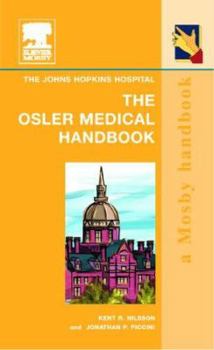The Osler Medical Handbook: Mobile Medicine Series
Written by experts at the Johns Hopkins Hospital, this brand-new 2nd Edition covers all of the essential topics encountered in daily practice. It concisely discusses all diseases and disorders in an easy-to-follow, standardized outline format. Each chapter includes sections on pearls and pitfalls, differential diagnoses, algorithms, and reviews of the most current literature. And, comparative pharmacology tables provide instant access to essential...
Format:Paperback
Language:English
ISBN:0323037488
ISBN13:9780323037488
Release Date:April 2006
Publisher:Saunders
Length:1072 Pages
Weight:1.40 lbs.
Dimensions:1.2" x 4.4" x 7.4"
Customer Reviews
3 ratings
Sole survivor
Published by Thriftbooks.com User , 16 years ago
I have skimmed over a lot of pocket manuals during my first year of IM residency (Ferri, Wash Manual, Rosen, Pocket Medicine, Oxford handbook), spending way too much money in the process. In the end I was left between Osler and Pocket Med. In a head-to-head comparison between the two, I was left with Osler as the triumphant source. While PM has it's value, it seems to rely heavily on buzzwords and "fast facts", without creating much substrate for deeper understanding. The OMH is a much more detailed review of key topics you will need to be familiar with throughout your residency. The Pearls and Pitfalls portion is very helpful. There are certain deficiencies, without a doubt. I do not like the fact that some chapters are only available in the PDA version, making studying these topics very annoying. Some subjects are totally overlooked (e.g. tick-borne diseases), while others have a little too long a discussion (such as sickle cell disease). Either way, I still feel more comfortable reading this book than PM, as it explains things a little more solidly and facilitates retention. If there is one thing I have learned, there is no one single source for learning Medicine, but there is a basic set of topics that are prerequisite knowledge for becoming an internist, and that can be learned very well from this book. The rest will come from inhouse experience, didactic sessions, articles, board review courses, et cetera. I strongly recommend this book for all IM residents, but don't let it (or any other manual, for that matter) shut your eyes to other sources.
Hope they'll fix PDA version in the next edition!
Published by Thriftbooks.com User , 18 years ago
Lots of good information in the book, but nothing you can look up quickly. The book is hefty and you need to read the table of contents beforehand so that you'll know what's available in the book. For example, there's an entire chapter on the gastrointestinal disorders in HIV, but this is not indexed. If you were to suddenly come upon a patient with HIV and GI complaints, you have to flip through the table of contents to find that chapter. If you look up HIV in the index, it does not refer to that chapter at all. Even worse is the PDA version. There is no built in index, as there is with the PDA version of the Washington Manual. To search, it uses the Palm OS search function which is slow and terrible. For example, if you scroll through the table of contents, you can eventually get to the section on migraines. If you do a search for migraines, you'll get the word Migraines on top (which you can not actually click on) and links to sections on other type of headaches which you CAN actually click on. A good PDA text should have an index that gives you a listing of all occurences of "migraine" with the chapter on migraines being the first link. I hope the next edition will have a better index and a better PDA version. A good handbook should be written with the idea that you will be walking around with this book in your pocket and if you suddenly get pimped, you should be able to look up the answer on the spot. A good PDA text would be ideal for this.
Chief Resident
Published by Thriftbooks.com User , 18 years ago
I was given a copy of the book at the Chief Resident's conference. It is fantastic!! I liked the first edition as a resident but this is far superior. The second edition is smaller and more carry-able. Chapters have more uniform organization that is easy to use. Charts/Algorithims are practical and capture common problems. Some key derm pictures. Getting the PDA (that has some additional chapters and formulary) is fantastic. The references have quality scores. Overall a great book for Internal Medicine residents and students. I will use it and will recommend it.






